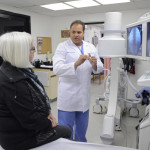Q: Is the neurostimulation procedure covered by insurance:
A: The majority of our treatments are covered by major insurance carriers. Your coverage for a given treatment will be determined by your specific benefits and medical history. We will work with your insurance provider to help you receive the best possible medical care. As with most surgical implants, this treatment may require a pre-authorization from your insurance carrier. This process can take up to four weeks and it involves review of your medical and treatment histories, along with a psychological evaluation.
Q: What is an implantable Neurostimulator?
A: It’s an implantable unit that goes under the skin to control pain. It can be compared to a pacemaker of the heart but it is a device that stimulates nerves to control pain. A little battery is placed under the skin to control wires that are also placed under the skin on the head. The wires have electrodes on them that stimulate the nerves that are causing the pain.
Q: How does neurostimulation work?
A: Electromagnetic fields in the wires stimulate the nerves in the head to mitigate or eliminate the migraine. Patients might feel a tingling sensation which they have described to be a soothing and relaxing sensation instead.
Q: Am I a good candidate?
A: Patients with severe and frequent headaches who have not responded to other treatment options are good candidates for this procedure.
Q: Why is the trial done and what happens during the trial?
A: A test (also known as the trial) stimulator is implanted for three days to see how it works for the patient. If the trial stimulator is successful, we then work with your insurance company to get pre-authorization for the permanent procedure. The trial stimulator feels exactly like the permanent stimulator will.
Q: How is the procedure done?
A: The permanent procedure is done about two weeks after the trial and the difference is that the battery is implanted under the skin versus at the top during the trial stimulator. There four small wires that look like IV tubes that are implanted right under this skin into the forehead and the back of the head. Two of them are placed under the skin above the eyebrows and the other two are in the back of the head. They are not visible once they have been implanted. The battery is implanted right under the skin in the lower back and it is connected to the wires that lead to the head. Those wires run through the back of the neck and back connecting to the battery.
Q: Will it cause physical limitations?
A: There are no cosmetic side effects and most people would not be able to tell that a patient has had the unit implanted. Patients have a contrary experience after the implant where now they can resume with their daily lives and activities that they were limited to before the implant. People have described to be able to be active and do things that previously would trigger the migraines.
Q: What are the risks or downsides?
A: Neurostimulation has been around for a very long time and the equipment and procedure has become very advanced with minimal downsides and risks when implanted for migraine headaches. The biggest downside would be that the stimulator does not work for a specific patient. However, it has been found that it will work in approximately 80 percent of patients.
Q: May I talk to a patient who has had the nuerostimulation implant?
A: Yes, patients often volunteer to share their experience with fellow migraine sufferers so that you can have a candid discussion about the procedure.
Q: Do you provide services other than the neurostimulation procedure?
A: Yes, we are dedicated to helping patients with a variety of chronic pain conditions including migraine headaches with different treatment options. A number of options will be discussed and tailored to each individuals needs. If you are suffering from other types of pain, visit us at www.killpain.com
Q: What’s the next step?
A: To get started, fill out the contact form on this website or call us at 800-000-0000. We will provide you with further information and answer any other questions that you may have.
Are you a candidate?
Are your migraines preventing you from your daily activities?
Are your migraines triggered by everyday things such as diet, exercise, light, noise?
Do your migraines last more than four hours at a time?
Have you tried different treatment options and taken a number of different medications?
Are you tired of your migraines controlling everything you do?
If you’ve answer YES to any of these questions, then you would be a good candidate for a neurostimulator.


